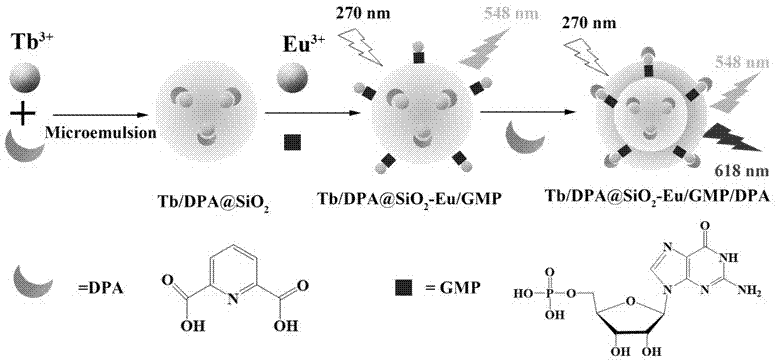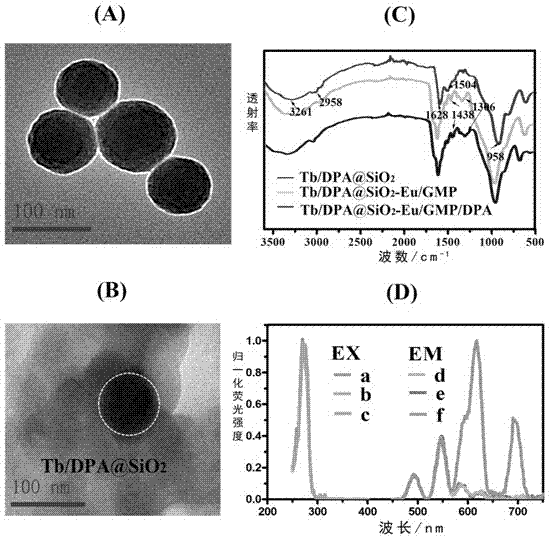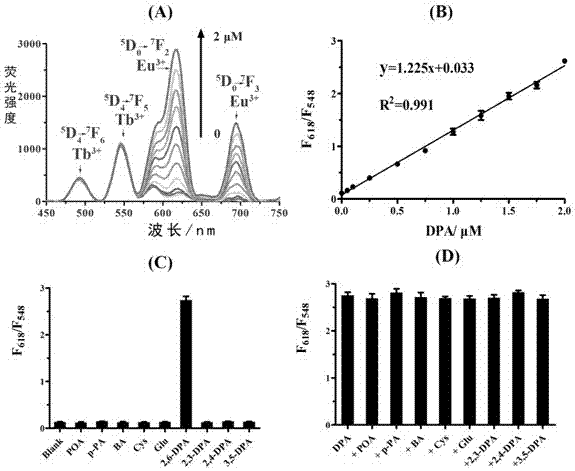Rate-type rare-earth fluorescent probe and application in detecting bacillus-anthracis biomarker
A rare-earth fluorescence and fluorescent probe technology, applied in the field of analytical chemistry, can solve problems such as difficult to achieve accurate, simple, portable and rapid detection, complex pre-preparation, etc., to eliminate the influence of background fluorescence and scattered fluorescence, high sensitivity and selectivity , cheap effect
- Summary
- Abstract
- Description
- Claims
- Application Information
AI Technical Summary
Problems solved by technology
Method used
Image
Examples
Embodiment 1
[0042] First prepare the fluorescent probe; add 500 μL of absolute ethanol containing 9.0 mg EDC and 2.8 mg NHS to 600 μL of 20 mM DPA solution, and stir for 40 minutes. Next, 100 μL of APTES was added and reacted for 100 minutes. Then, add 200 μL of 20 mM Tb(NO 3 ) 3 solution into the mixed solution. The resulting mixture was used as a precursor. Then, Tb / DPA@SiO was prepared by the inverse microemulsion method 2 . Use 1 mL of n-hexanol, 1 mL of Triton X-100 and 4 mL of cyclohexane to make a microemulsion and add it to 300 μL of the previously prepared Tb / DPA solution. After 40 minutes of continuous stirring, add 25 μL of ammonia to the solution aqueous solution (28%) and 85 μL of TEOS. The stirred reaction was continued for 24 hours. An equal volume of acetone was used to separate the nanoparticles from the microemulsion and centrifuged 3 times with ethanol and water washes. In order to prepare amino-modified Tb / DPA@SiO 2 -NH 2 , the Tb / DPA@SiO 2 Suspended in the ...
Embodiment 2
[0044] Mix 500 μL of 2 mM GMP solution and 1.0 mL of 0.5 mg / mL Tb / DPA@SiO 2 -NH 2 The solutions were mixed and then shaken for 30 minutes. Next, 500 µL of 2 mM Eu(NO 3 ) 3 Add to the mixed solution and shake at room temperature for 100 minutes. Then, the product was collected by centrifugation at 10000 rpm for 5 minutes, and washed 3 times with ultrapure water to remove unreacted reagents. Finally, the Tb / DPA@SiO 2 -Eu / GMP mixture stored in 2 mL H 2 O for further use. (The prepared material is characterized as figure 2 as shown, figure 2 (A) is Tb / DPA@SiO 2 -NH 2 The transmission scanning electron microscope characterization diagram of figure 2 (B) is Tb / DPA@SiO 2 -NH 2 The transmission scanning electron microscope characterization diagram of figure 2 (C) is Tb / DPA@SiO 2 -NH 2 , Tb / DPA@SiO 2 -Eu / GMP, Tb / DPA@SiO 2 - Infrared spectrum characterization of Eu / GMP / DPA, figure 2 (D) is Tb / DPA@SiO 2 - Fluorescence excitation EX and emission spectra EM) of Eu / ...
Embodiment 3
[0046] DPA was detected with the prepared fluorescent probe and the aforementioned detection conditions. Add 80 μL of Tris-HCl buffer (pH 7.4, 50 mM) to 10 μL of the prepared Tb / DPA@SiO 2 -Eu / GMP solution. Afterwards, 10 μL of DPA of different concentrations (0.25-20 µM) was added to the above solution. The final concentration of Tris-HCl was 40 mM, while the final concentration of DPA was in the range of 0.025-2.0 µM. In order to explore the selectivity of ratiometric fluorescent probes for detecting DPA, different materials were selected for interference experiments, including phenoxyacetic acid (POA), terephthalic acid (p-PA), benzoic acid (BA), cysteine amino acid (Cys), glutamic acid (Glu), the final concentration of these substances is 50 μM. Finally, the emission spectra were recorded under excitation at a wavelength of 272 nm. When the concentration is 0.025-2.0 µM, the fluorescence intensity is linearly related to the DPA concentration: Y=1.225X+0.033, R 2 =0.991...
PUM
| Property | Measurement | Unit |
|---|---|---|
| diameter | aaaaa | aaaaa |
| concentration | aaaaa | aaaaa |
| recovery rate | aaaaa | aaaaa |
Abstract
Description
Claims
Application Information
 Login to View More
Login to View More - R&D
- Intellectual Property
- Life Sciences
- Materials
- Tech Scout
- Unparalleled Data Quality
- Higher Quality Content
- 60% Fewer Hallucinations
Browse by: Latest US Patents, China's latest patents, Technical Efficacy Thesaurus, Application Domain, Technology Topic, Popular Technical Reports.
© 2025 PatSnap. All rights reserved.Legal|Privacy policy|Modern Slavery Act Transparency Statement|Sitemap|About US| Contact US: help@patsnap.com



